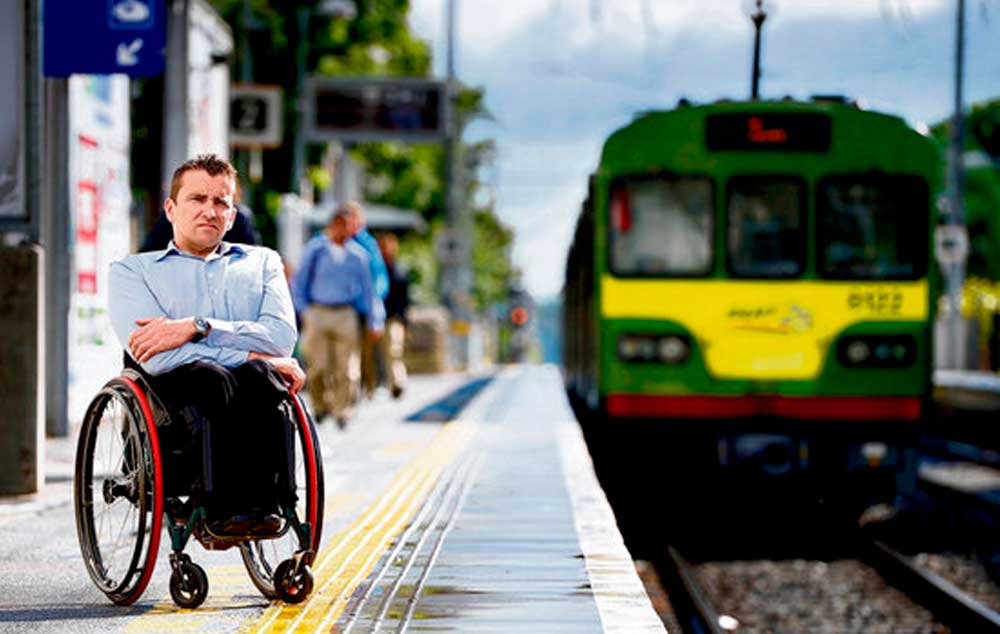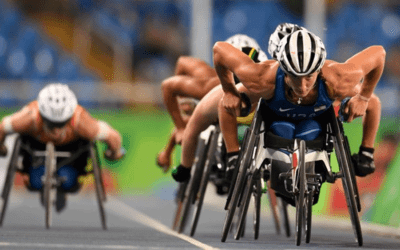
Improving accessibility is sound business practice
The Paralympics showcased the ability of wheelchair users but, in the real world, a daily obstacle course continues, writes LOUISE BRUTON
IF YOU are part of the 13 per cent of the Irish population with a disability, then you know Dublin’s city centre is an obstacle course – and that you don’t get a medal for completing it.
Getting around is difficult, as public transport is unreliable or unsuitable and footpaths are uneven or can be cordoned off due to road works. When you reach your destination, you may discover there is no way to get inside unless some bystander lends a hand.
Once inside, seeking to perform a basic task such as using the bathroom could leave you heading back out the door searching for a McDonald’s.
While building regulations since 1990 have outlined access needs for people with disabilities, it is only since January 1st, 2010 that all new buildings and renovated buildings have to acquire a disability access certificate. Any building, with the exception of a private home, requiring planning permission or a fire certificate has to attain the disability cert – which costs €800 – and work cannot commence without it.
The condition – laid down under Part M of the Building Control Regulations 2010 – does not apply to older buildings, however, which means there is no legal obligation to adjust the many public properties constructed during the boom years, or earlier. But is there a moral obligation?
The regulations say “buildings should be designed so that they are easy for people to use and reflect the fact that all people experience changes in their abilities as they progress through the different stage of life”. The Government has committed to a 2015 deadline to make its buildings fully compliant with the regulations, and, while they appear to be on target, these spaces are not part of everyone’s daily routine.
There are other public spaces as well as commercial properties which are used by people of all ages, backgrounds and abilities, and by omitting these from adjustments some people are immediately excluded from their services.
The 2011 Census reported that 13 per cent of the population (595,335) had a disability, up from 9.3 per cent (393,785) in 2006. But a survey by the National Disability Authority concluded the figure could be closer to 18.5 per cent, depending on the definition of disability.
Kanchi, a non-profit organisation which works with businesses on disability and which last week held a conference on the issue with healthcare company Covidien, argues that if retailers improved at least one aspect of accessibility they could increase their custom by up to 20 per cent.
“It is worth keeping in mind that it isn’t only people with disabilities that will benefit from more accessibility,” its network manager Nikki Hegarty says. “A shop that is easy for a wheelchair user to negotiate will also be easier for a mum with a pram; a large-font menu will not only be easier for someone that is visually impaired, it will also help for someone that has simply forgotten their reading glasses.”
A good news story is the fact Dublin Bus plans to have a fully accessible fleet by the end of this year.
“To date, 92 per cent of the Dublin Bus fleet is low floor wheelchair accessible, and the fleet will be fully accessible by the close of 2012 due to the introduction of 80 replacement buses . . . on a phased basis,” says Brendan Cushen, Dublin Bus communications officer.
The company also has a free travel assistance scheme which promotes “independent use of public transport” by arranging a trained assistant to accompany anyone for the first few times on the bus and also on the Dart and Luas.
But public transport still isn’t practical for everyone, says John Fulham, media manager for Ireland’s successful Paralympic team. “I live in Donabate, and over Christmas I went into town from my train station to meet friends. When I went to the train station – they say that they have ramps – but on this Saturday, there was no one tending the station, so I had four young fellas lift me up on to the train.
“On the way home from Connolly Station at 10 o’clock there was nobody there and, therefore, I literally had to get out of my chair, crawl up and pull my chair on to the train.
“When I got back to Donabate, there was nobody there again and I was the only person getting off at that station.
“ I decided that I would bounce off the train but I probably could have fallen and hit my head. “They are trying to cater and to improve things but there is a long way to go with things.”
Iarnród Éireann recommends that passengers with a disability let it know at least 24 hours in advance of their journey and what arrangements they will need.
Spokeswoman Jane Cregan said that when notified, each station was fully equipped to assist anyone.
“Some stations are built on a curve so, in some instances, there is a wide gap between the platform and the train, such as on Platform 5 in Connolly, and also in Cork. In these instances, there is an announcement on the train alerting people to the gap.”
Fulham says he is lucky he can manage Dublin’s many bumps and dips but it’s a different story for many others.
“I will be positive and say that it is far more accessible than it was previously. But at a practical level, when they put down new kerbs, there still is a lip between the road and the kerb . . . For me, it’s fine, but that would pose great difficulty for someone who isn’t as agile in a chair.”
A spokesman for Dublin City Council said these lips were a necessity for engineering reasons. “Footpath ‘dishings’ are generally constructed with a 6mm or less lip to provide for drainage in the channel beside the kerb line. Where there is a favourable gradient on the footpath and carriageway there is no need to provide this lip.”
Campaigners say Dublin rates well against other capital cities such as London and New York when it comes to accessibility. But Hegarty says improvements shouldn’t end in the capital.
“There are very few businesses today that can afford to turn away customers, but this is effectively what they are doing when their premises or services are inaccessible to people with disabilities,” she adds.
OBSTACLE COURSE: FIVE WAYS TO IMPROVE
1. Online information and technology: In London, those who use wheelchairs or buggies benefit from a phone app called LDN Access that maps out the city in terms of accessibility. It was co-created by Daniel Biddle, a survivor of the 2005 London bombings who lost both of his legs, and it allows those with mobility issues to plan their day with ease.
Currently, there is no Dublin access app. Dublin City Council’s AccessDublin.ie website, however, provides relevant information.
2. Business for everyone: Amie Hynes Fitzpatrick, communications officer with disability lobby group Kanchi, has a visual impairment. “Accessibility isn’t just a ramp at the front door or a Braille sign at a reception desk. Real accessibility is being able to access goods and services, and interact with people the same way everyone else does,” she says.
Caroline Carswell is one of the 800,000 people in Ireland who has a hearing impairment. She is the founder of Irishdeafkids.ie, a website that supports inclusive mainstream education for deaf children in Ireland. She cites door intercoms as one underappreciated obstacle.
“I can’t hear the buzzer so I keep pushing the door and pressing the buzzer at the same time. Sometimes I just give up and have to wait for someone else . . . It would be really good to have a light to show that your actions have been responded to. Or maybe in five or 10 years, we could have real-time text, which would have what the receptionist says come up on a screen outside as well.”
3. Open up protected and historical buildings: Many city centre offices are in Georgian buildings, which are considered protected heritage buildings with restrictions on renovations. Campaigners say if you are renting an office space, consider the people whose options you are limiting because of layout.
4. Transport and signage: While the majority of Dublin Buss fleet is accessible, other improvements are needed. If the company’s phone app could indicate which buses are accessible, it would improve their services for many people.Those with partial or poor vision say it is important that signs in public places or at big events use a large clear font. This is so they can know what’s going on and retain their independence as they go about.
5. Playgrounds and parks: Orlaith Sweetman-Healy is five and she uses a wheelchair. Her local playground in Inchicore has a swing with a bucket seat, which Orlaith loves, but she would like to see more adapted playgrounds and further improvements in parks.
Her mother Cathie says: “Some of the local parks have difficult access points for people with wheelchairs. There needs to be a standardised gate, which is easily opened, in all public parks. These gates would have an access button at a lower level for ease of use. Items like bollards need to be removable and walkways need to be widened to suit wheelchair-users.
Source: irishtimes.com
Compartilhe
Use os ícones flutuantes na borda lateral esquerda desta página
Siga-nos!
Envolva-se em nosso conteúdo, seus comentários são bem-vindos!
Artigos relacionados
Acessibilidade no ESG. Equipotel aborda o tema para o turismo.
Acessibilidade no ESG, para o mercado do turismo. Equipotel aborda a importância da inclusão da pessoa com deficiência.
Morte Sobre Rodas. Filme inclusivo foi candidato ao Oscar.
Morte Sobre Rodas. Dois protagonistas do filme, são pessoas com deficiência, um usuário de cadeira de rodas e outro com paralisia cerebral.
Paralimpíada de Paris 2024. A deficiência não é um limite.
Paralimpíada de Paris 2024. A cidade luz sedia o maior evento esportivo do mundo para as pessoas com deficiência.






0 comentários